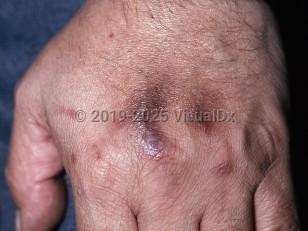Drug-induced pigmentation in Child
Alerts and Notices
Important News & Links
Synopsis

Minocycline-induced pigmentation is of special note as it has been among the most widely used of these medications in adolescents, as a primary antibiotic choice in the treatment of moderate to severe acne vulgaris. Usually, the pigmentation develops after a year or more of therapy, but it has been reported to occur after just a few weeks to a couple of months.
Related topics: drug-induced flagellate pigmentation, amiodarone drug-induced pigmentation, drug-induced hypopigmentation, drug-induced oral pigmentation, drug-induced nail pigment, fixed drug eruption
Codes
L81.9 – Disorder of pigmentation, unspecified
T50.905A – Adverse effect of unspecified drugs, medicaments and biological substances, initial encounter
SNOMEDCT:
110284009 – Drug-induced pigmentation
Look For
Subscription Required
Diagnostic Pearls
Subscription Required
Differential Diagnosis & Pitfalls

Subscription Required
Best Tests
Subscription Required
Management Pearls
Subscription Required
Therapy
Subscription Required
Drug Reaction Data
Subscription Required
References
Subscription Required
Last Updated:01/18/2023

